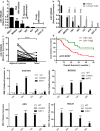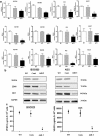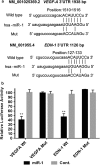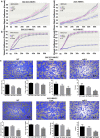MicroRNA-1 acts as a tumor suppressor microRNA by inhibiting angiogenesis-related growth factors in human gastric cancer
- PMID: 28493075
- PMCID: PMC5741792
- DOI: 10.1007/s10120-017-0721-x
MicroRNA-1 acts as a tumor suppressor microRNA by inhibiting angiogenesis-related growth factors in human gastric cancer
Abstract
Background: We recently reported that miR-1 was one of the most significantly downregulated microRNAs in gastric cancer (GC) patients from The Cancer Genome Atlas microRNA sequencing data. Here we aim to elucidate the role of miR-1 in gastric carcinogenesis.
Methods: We measured miR-1 expression in human GC cell lines and 90 paired primary GC samples, and analyzed the association of its status with clinicopathological features. The effect of miR-1 on GC cells was evaluated by proliferation and migration assay. To identify the target genes of miR-1, bioinformatic analysis and protein array analysis were performed. Moreover, the regulation mechanism of miR-1 with regard to these predicted targets was investigated by quantitative PCR (qPCR), Western blot, ELISA, and endothelial cell tube formation. The putative binding site of miR-1 on target genes was assessed by a reporter assay.
Results: Expression of miR-1 was obviously decreased in GC cell lines and primary tissues. Patients with low miR-1 expression had significantly shorter overall survival compared with those with high miR-1 expression (P = 0.0027). Overexpression of miR-1 in GC cells inhibited proliferation, migration, and tube formation of endothelial cells by suppressing expression of vascular endothelial growth factor A (VEGF-A) and endothelin 1 (EDN1). Conversely, inhibition of miR-1 with use of antago-miR-1 caused an increase in expression of VEGF-A and EDN1 in nonmalignant GC cells or low-malignancy GC cells.
Conclusions: MiR-1 acts as a tumor suppressor by inhibiting angiogenesis-related growth factors in human gastric cancer. Downregulated miR-1 not only promotes cellular proliferation and migration of GC cells, but may activates proangiogenesis signaling and stimulates the proliferation and migration of endothelial cells, indicating the possibility of new strategies for GC therapy.
Keywords: Angiogenesis; Gastric cancer; Vascular endothelial growth factor A; miR-1.
Conflict of interest statement
Conflict of interest
The authors declare that they have no conflict of interest.
Research involving human participants and/or animals and informed consent
All samples were obtained with patients’ informed consent. The Ethics Committee of Beijing Cancer Hospital approved this study. This study does not involve animals.
Figures





Similar articles
-
Reduced miR-126 expression facilitates angiogenesis of gastric cancer through its regulation on VEGF-A.Oncotarget. 2014 Dec 15;5(23):11873-85. doi: 10.18632/oncotarget.2662. Oncotarget. 2014. PMID: 25428912 Free PMC article.
-
MicroRNA-596 acts as a tumor suppressor in gastric cancer and is upregulated by promotor demethylation.World J Gastroenterol. 2019 Mar 14;25(10):1224-1237. doi: 10.3748/wjg.v25.i10.1224. World J Gastroenterol. 2019. PMID: 30886505 Free PMC article.
-
MiR-205-5p suppresses angiogenesis in gastric cancer by downregulating the expression of VEGFA and FGF1.Exp Cell Res. 2021 Jul 15;404(2):112579. doi: 10.1016/j.yexcr.2021.112579. Epub 2021 May 4. Exp Cell Res. 2021. PMID: 33957117
-
MicroRNA-mediated regulation of the angiogenic switch.Curr Opin Hematol. 2011 May;18(3):171-6. doi: 10.1097/MOH.0b013e328345a180. Curr Opin Hematol. 2011. PMID: 21423013 Free PMC article. Review.
-
miR-126: a bridge between cancer and exercise.Cancer Cell Int. 2025 Apr 15;25(1):145. doi: 10.1186/s12935-025-03784-0. Cancer Cell Int. 2025. PMID: 40234897 Free PMC article. Review.
Cited by
-
Overexpression of MicroRNA-1 in Prostate Cancer Cells Modulates the Blood Vessel System of an In Vivo Hen's Egg Test-Chorioallantoic Membrane Model.In Vivo. 2019 Jan-Feb;33(1):41-46. doi: 10.21873/invivo.11436. In Vivo. 2019. PMID: 30587600 Free PMC article.
-
Cell Growth Stimulation, Cell Cycle Alternation, and Anti-Apoptosis Effects of Bovine Bone Collagen Hydrolysates Derived Peptides on MC3T3-E1 Cells Ex Vivo.Molecules. 2020 May 14;25(10):2305. doi: 10.3390/molecules25102305. Molecules. 2020. PMID: 32422931 Free PMC article.
-
miR-100 inhibits cell proliferation in mantle cell lymphoma by targeting mTOR.Exp Hematol Oncol. 2020 Sep 26;9:25. doi: 10.1186/s40164-020-00182-2. eCollection 2020. Exp Hematol Oncol. 2020. PMID: 32999755 Free PMC article.
-
Syndecan-1 Promotes Angiogenesis in Triple-Negative Breast Cancer through the Prognostically Relevant Tissue Factor Pathway and Additional Angiogenic Routes.Cancers (Basel). 2021 May 12;13(10):2318. doi: 10.3390/cancers13102318. Cancers (Basel). 2021. PMID: 34066023 Free PMC article.
-
miR‑1 reverses multidrug resistance in gastric cancer cells via downregulation of sorcin through promoting the accumulation of intracellular drugs and apoptosis of cells.Int J Oncol. 2019 Aug;55(2):451-461. doi: 10.3892/ijo.2019.4831. Epub 2019 Jun 25. Int J Oncol. 2019. PMID: 31268161 Free PMC article.
References
-
- Ferlay J, Soerjomataram I, Ervik M, Dikshit R, Eser S, Mathers C, Rebelo M, Parkin DM, Forman D, Bray, F. GLOBOCAN 2012 v1.0, cancer incidence and mortality worldwide: IARC CancerBase no. 11. Lyon: International Agency for Research on Cancer; 2013. Available from http://globocan.iarc.fr - PubMed
MeSH terms
Substances
Grants and funding
LinkOut - more resources
Full Text Sources
Other Literature Sources
Medical
Miscellaneous

